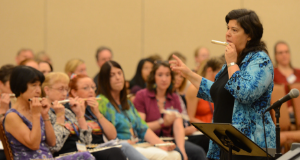News & Updates
Recent Blog Posts
Why and How I Learned Circular Breathing
By Robert Dick
Here are some of my thoughts on why I learned circular breathing and how I developed my method to teach it (which is presented in my book Circular Breathing for the Flutist).
From August 1977 through January 1978, I worked at the Institute for Research and Coordination in Acoustics/Music in Paris. During that time, I met several flutists who could circular breathe. On listening carefully, I must admit I had my doubts. I remember thinking, If this is as good as circular breathed flute-playing can sound, I’m not sure it’s worth the trouble. During my time at IRCAM, I received an invitation from Aurèle Nicolet to give a class for his students at the Musikhochschule in Freiburg, Germany. My first European class! I was so excited, especially to meet Nicolet himself, whose recordings I much admired.
While in Freiburg, I asked Prof. Nicolet about circular breathing, because I had heard that he could do it. When he demonstrated playing with circular breathing, I was convinced! His tone was perfectly seamless, and the breathing was audibly “invisible;” there was no way to tell from the sound that he was circular breathing. This was the level that I aspire to in all technical work—that the technique never calls attention to itself but is there as a conduit of musical expression.
Prof. Nicolet gave me his explanation of circular breathing. It was short and simple—actually the same explanation I had heard from other players, woodwind and brass, who could circular breathe.* I realized that the difference was because of Nicolet’s musical vision and his dedication to fully realizing it. He asked me if I thought I understood, and I replied that I did. He then said, “Good. It is yours for the doing. If you do it!”
In a flash, I could see a myriad of musical uses for circular breathing in all sorts of music, old, new, and as yet unimagined! I felt I could add a superpower to my playing! You don’t have to use it all the time, and replacing all breathing with circular breathing would be stupidly unmusical. But when the music asked for it, how great it would be to be able to respond. In ensuing years, I used circular breathing to great effect when I was principal flutist of the Brooklyn Philharmonic in New York and of course have made it part and parcel of my compositional and improvisational approaches to the flute.
As I was soon to be returning from Paris to my position in the Creative Associates, a contemporary music ensemble based in Buffalo, New York, I decided to make learning circular breathing my top priority when I got back to Buffalo. I really worked hard at it but was frustrated by the slowness of my progress. I had been playing the flute for twenty years at that point and had a good idea of what I could accomplish in an hour of practice. With circular breathing, I was making a tiny percentage of that expected progress. Not being the type to quit, I kept at it and found, eventually, that I had passed some sort of mysterious threshold, and circular breathing began to work and began to become easy!
I started to incorporate circular breathing into the music I was creating and also in classical music at spots where I felt that a “breath assist” would help me phrase the way I believed the music should go, rather than having the phrasing shaped by the physical need to breathe. Everything was working in a positive light, and I was delighted with the developments in my playing, interpretively and flutistically.
And then students started to ask me to teach them how to circular breathe. This was infinitely more frustrating than the learning process that I had gone through by myself. With only a brief description of the mechanics of circular breathing, there was no real pedagogy, no step-by-step plan. As a teacher, I was reduced to cheerleading: “You can do it! You can do it! Just keep working!” I know you can do it!
I hated this pathetic excuse for real teaching and was intensely thinking about better ways to teach and learn circular breathing. I began to realize that, for the flute, the traditional approach to learning circular breathing was backwards. Everyone started with the breathing itself, and it would actually make more sense to prepare the embouchure and then apply the breathing.
Perhaps the easiest instrument to learn circular breathing on is the oboe, the diametric opposite of the flute in terms of pressure and airflow. The oboe uses very much less air than the flute, under much higher pressure—and circular breathing is truly easy on it. The oboist can have three to five seconds (or more) to play with the air that is in the mouth, loads of time to inhale. (It’s a mystery, frankly, that so many oboists persist in turning bright colors followed by gasping instead of using the natural breathing rhythm that circular breathing would easily make available to them.)
The flute is the instrument that uses the most air of all the wind and brass instruments (including the tuba) under the lowest pressure. Flutists have no reed to hold onto, no mouthpiece to support the embouchure, and virtually no back pressure to help regulate the airflow. I came to understand that concentrating on the breathing before the embouchure was developed to handle the many stages of circular breathing was simply illogical and ineffective.
Once I had this core insight, I was able to create a step-by-step method for flutists to learn circular breathing, and I’m happy to report that very many flutists have successfully learned the technique from my book Circular Breathing for the Flutist.
Over the decades—twenty years of playing back in 1978 have continued to over sixty years at present—I have continued to refine circular breathing and apply it to ever-growing musical ideas. I’ve developed circular breathing in staccato passages and also in constantly evolving multiphonic musical languages that demand embouchure techniques that I couldn’t even have imagined back in the 1970s.
And that is the joy of a creative life. That we can always be learning new things and following our music to the farthest places it wants to go is our privilege and purpose.
*And what was that simple explanation of circular breathing? It went like this:
- While playing, the flutist stores some air in the mouth by inflating the cheeks.
- When the cheeks are inflated, the back of the tongue moves upwards to touch the back of the hard palate. There is now a separate reservoir of air in the mouth and an open pathway from the nostrils to the lungs.
- SIMULTANEOUSLY, the flutist plays for a very short time by squeezing the air out of the mouth and the cheek (and sometimes tongue) muscles AND inhales a small bit of air through the nose.
- The back of the tongue returns to the normal position, restoring airflow from the lungs to the flute.
- The cycle begins anew and goes round and round, which is why it has come to be known as circular breathing.
Community
Read updates from members and committees, post and view job and internship opportunities, and more.


Yuko Hoshi
The NFA, I believe, is an amazing hub of a worldwide flute community where members living outside the U.S., like myself, are given equal opportunities. I have met so many wonderful people from all over the world through the NFA. Come on and join us! Let’s play together!”
Membership With the NFA
Exclusive Member Benefits
- A subscription to The Flutist Quarterly.
- Discounts to SmartMusic Software, Principal Flute, and other partners.
- Unlimited access to Naxos Music Library and Grove Music Online.
.
Membership Options
The NFA welcomes students, student groups, libraries, and commercial members with special membership options.
"I am the NFA"
Our members make us who we are. Meet some of the members of the NFA and see why we inspire flutists and enrich lives.
Events
Browse performances, masterclasses, competitions, and more from the community.

Publications
The Flutist Quarterly
The Flutist Quarterly provides information and articles about the performance, study, history, manufacture, and enjoyment of flutes, flutists, and flute music.
FQ Plus
FQ Plus offers feature articles, interactive features, and news about flute events and people.
Committees

NFA Committees
Jobs & Internships

Donate To The NFA
Support the flute community
Your gifts helps ensure that the NFA continues to provide the highest level of service to its membership. Please consider making a tax-deductible gift to support the NFA’s operations and programs.
In celebration of “125 Years of Exquisite Flutemaking,” the Wm. S. Haynes Co. made a $125,000, 10-year commitment to the National Flute Association, for the years 2013-2022. This was recently extended to last until 2027. Learn more about it here.
